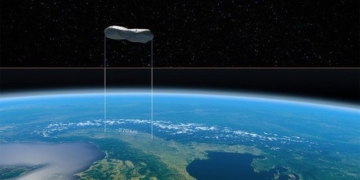On the International Space Station (ISS), astronauts use specialized equipment from Russia and the United States to measure body mass instead of weight.
The microgravity environment in low Earth orbit poses harsh conditions for the human body. The effects of this environment are still under study, and astronauts must ensure they maintain optimal fitness while living weightless aboard the International Space Station (ISS).

Astronaut André Kuipers from the European Space Agency (ESA) uses the SLAMMD to measure body mass. (Photo: NASA/ESA).
On Earth, exercise routines often depend on weight. But how do astronauts measure their weight when they are almost in a weightless state in space? In fact, there are two devices on the ISS that assist them in this task: The Space Linear Acceleration Mass Measurement Device (SLAMMD) from NASA and the Body Mass Measurement Device (BMMD) from Russia. Both utilize spring mechanics to measure the body mass of astronauts rather than their weight.
A person’s weight is their mass multiplied by the gravitational acceleration acting on them. For example, gravity on the Moon is less than that on Earth, so Apollo astronauts felt “lighter” when walking on the lunar surface. However, their mass remained unchanged. This is why astronauts on the ISS measure body mass instead of weight.
Mass, like weight, is typically measured in kilograms. This can lead to confusion for many. Mass is the amount of matter that the body contains, regardless of the gravitational force.
The SLAMMD applies Isaac Newton’s second law of motion: The strength of a force is equal to the mass it acts upon multiplied by the acceleration of that mass (F = ma). Located within the Columbus laboratory built by Europe on the ISS, SLAMMD is part of the Human Research Facility – a drawer containing numerous integrated devices. SLAMMD extends out on a “guiding arm.”
To use the SLAMMD, astronauts must wrap their legs around the foot support, place their abdomen against the abdominal cushion, and rest their chin on the headrest. Two springs in a drawer are released, and their force pushes the guiding arm towards the astronaut, causing them to be pushed backwards.
The astronauts know the force exerted by the springs because they are manufactured to certain specifications. The astronaut’s acceleration when pushed by the springs is measured using an optical instrument that tracks the motion of the guiding arm and its speed. Acceleration is calculated by taking the change in velocity over a distance (approximately one meter) divided by the time taken. Then, a computer connected to the SLAMMD performs the simple calculation F = ma to determine the astronaut’s body mass with an accuracy of 0.2 kg.

NASA astronaut Tom Marshburn uses the Body Mass Measurement Device (BMMD) in the Zvezda service module on the ISS. (Photo: NASA).
The BMMD device from Russia is located in the Zvezda module of the ISS. Similar to the SLAMMD, it also uses springs. However, instead of a single push, an astronaut squats on the device and moves up and down like a pogo stick. The oscillation speed of the device depends on the astronaut’s mass: when no one is sitting on it, the BMMD oscillates much faster. Therefore, timing the oscillation will help estimate the astronaut’s body mass.
Measuring body mass is critical in space to ensure that astronauts do not lose too much mass. This is important because humans lose an average of 1% of bone density each month in this harsh environment. Muscles also atrophy, and the heart weakens as it doesn’t have to work as hard to pump blood throughout the body.
To counteract the effects of microgravity, astronauts on the ISS exercise for two hours each day in the station’s gym to maintain muscle mass, bone density, and cardiovascular health. Measuring body mass helps assess whether they are healthy and fit.





















































